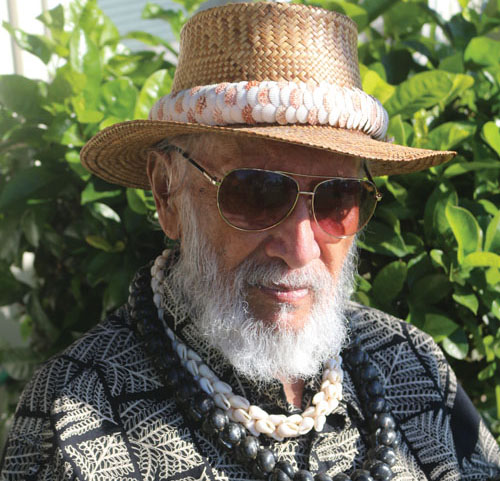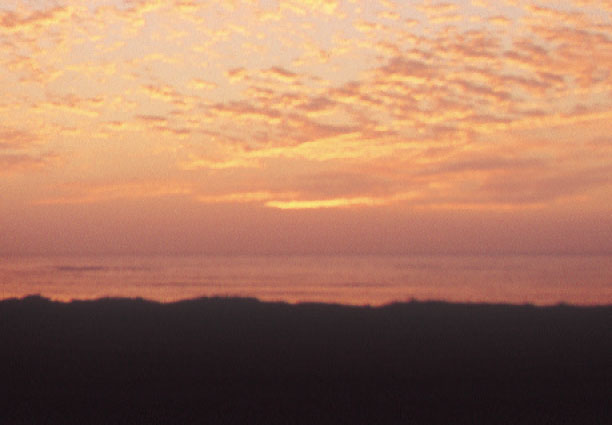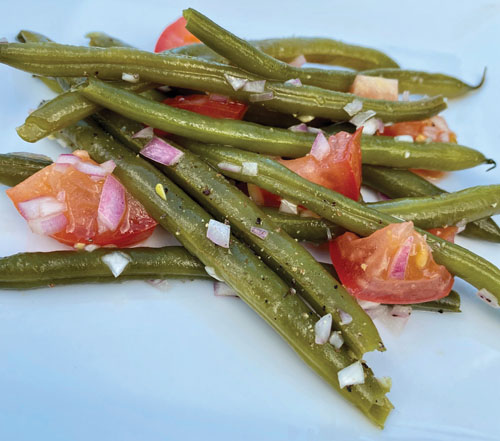
The Bray ‘Ohana—A Talented Family’s Deep Connection

By Catherine Tarleton
The story of the Bray ‘ohana reaches back through generations—from Hawai‘i, back to Tahiti, back to ancient knowledge, history, culture, and wisdom.
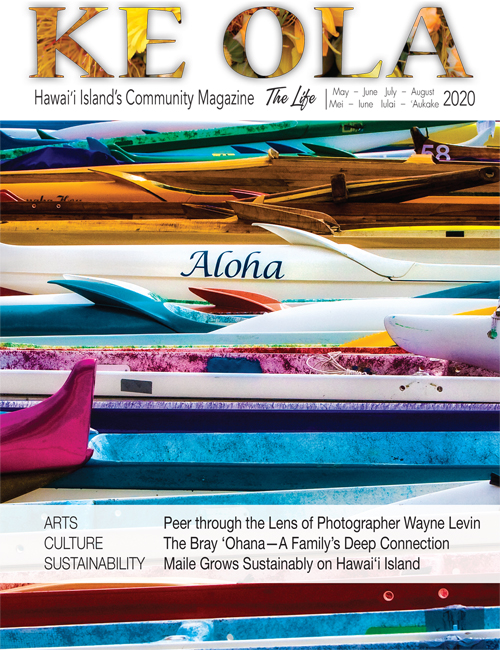
“I have a book written by my great-grandfather,” says Lelehua Bray, hula teacher, travel professional, wife, mom, and keeper of so many family memories. Her great-grandfather was David Kaonohiokala “Daddy” Bray, a practicing kahuna (priest or shaman), born in 1889. “In that book, he talks about our family’s ancestry, hula, culture, the whole thing,” she continues.
His unpublished manuscript is in a well-worn three-ring binder, which her friend Donna Kimura helped her organize some years back. Itʻs filled with both handwritten and typed pages, with notes in the margins, and pictures tucked in plastic pockets. In it, Daddy Bray tells of his genealogical ties to Pa‘ao, the formidable Tahitian priest who came to Hawai‘i about 1200 AD, and is said to have established (or re-established) a rigorous kapu system for the maintenance of law and order.
Historian Abraham Fornander writes that before Pa‘ao landed on Hawai‘i Island, “the kapus [sic] were few and the ceremonials easy; human sacrifices were not practiced; and government was more of a patriarchal than of a regal nature.” The kapu system was a controlling way of life for Hawaiians—from everyday eating, to annual farming and fishing cycles, religious rituals, and more—until Captain James Cook’s arrival in 1778.
By 1819, King Kamehameha I had died, the ali‘i had defied the ‘ai kapu (the taboo against men and women eating together), and thrown down the entire kapu system. Christian missionaries arrived soon after, and the culture of the kāhuna went underground. Ancestors of Pa‘ao, like Daddy Bray, maintained a spiritual connection to the old gods as well as embracing the Christian God.
But we are getting ahead of ourselves. Or behind.

“Growing up, I never met my great-grandfather; he died one month before I was born,” says Lelehua. Daddy Bray’s father was David Howard Hitchcock, a Hindu-English seaman, half-brother of D. Howard Hitchcock, known for his paintings of Hawaiian volcanoes. His mother, Hana Bray, was Hawaiian—granddaughter of Namahana Namahana (married to William Bray III). Her grandfather was Holoa‘e, advisor to King Kamehameha I, present on the day Captain Cook sailed into Kealakekua Bay.
Daddy Bray’s mother died when he was six months old, and he was adopted by his aunt Lukia, who trained him in the ways of the kāhuna. “Daddy Bray was from the Pa‘ao and Holo‘ae lineage, that was the kāhuna side,” says Lelehua. “My great-grandmother is the hula side.” Born and raised in Hāna, Maui, Lydia Maunahina Dusson “Mama” Bray was given her name by Queen Lili‘uokalani (b. Lydia Lili‘u Kamaka‘ehu). She became one of Hawai‘i’s premier kumu hula.
In 1919, the Brays founded a hula hālau (troupe) to help revive that revered tradition, suppressed by the previous century’s rapid change. They also taught classes in culture, legends, language, and songs, and began to entertain visitors as well. In the 1930s they started organizing festivals and events featuring Hawaiian entertainers. And, 100 years later, Daddy and Mama Bray were inducted into the Hawaiian Music Hall of Fame in recognition of their contributions to hula.
“My great-grandmother was in the movie Bird of Paradise,” says Lelehua, referring to the 1932 film starring Delores del Rio. “My great-grandmother and Aunty ‘Io [‘Iolani Luahine] choreographed the whole thing.” (Daddy Bray also appeared in the film as a chanter, uncredited.)

Present Day
“Hula just kind of happened. It was the path thrown out before me,” Lelehua says. “My journey was hula. I know for a fact it’s in my blood, my genealogy, and that’s why I love hula so much.”
Lelehua was born in Kealakekua, South Kona, the oldest of seven children. “My dad is Hawaiian-Caucasian, and my mom is pure Sicilian,” Lelehua says. Recounting a favorite family story, she says, “My father went to Kamehameha School. Mom went to Punahou. They both got expelled senior year because she was hāpai with me. They graduated from Roosevelt!” she says with a laugh.
She grew up on two islands, Hawai‘i and Kaua‘i, and her father worked for Aloha Airlines at the time. “Dad died in 2008, at the age of only 58,” she says fondly. “But you can see what he left; he left us his art.” Her father, David M. Bray, was a gifted painter, bringing to life vivid, colorful Hawaiian images—a collection of still lifes with koa bowls and hula implements, busy scenes of people and canoes, and much more.
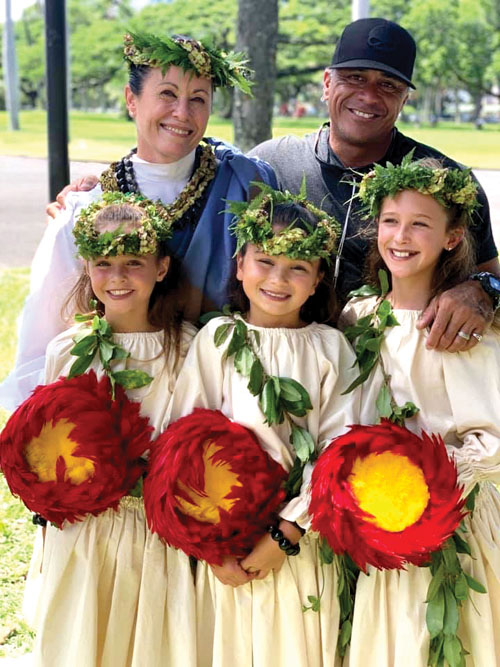
Says Lelehua, “I had my first hula lesson in the second grade, with Kumu Roselle Bailey, in Kamakani, Kaua‘i…I was in Merrie Monarch with her when I was 14 years old. It was always exhibition for us, not competition.” Going back and forth between islands, Lelehua also studied hula (and still does) with Kumu Michael Pili Pang in Waimea (Kamuela).
“One of the cool things about Michael, he has the ability to write and manage all these grants,” Lelehua says. “Weʻve had the privilege to share hula in Taiwan, Quebec, and at the Museum of Natural History in New York City.”
Between 1995 and 2001, Lelehua completed the ‘ūniki (graduation protocols) with Kumu Michael as a dancer, chanter, and a teacher (‘ōlapa, ho‘opa‘a, and kumu). In 2009, she founded her own hula hālau, Hālau Hula Maunalei, in Hōlualoa.
Now, Kumu Lelehua teaches hula to students of all ages, from her youngest keiki, to her “gracious ladies” ages 70 and up. Classes are held at the old Hōlualoa Theatre, shared with the Martial Achievement Center, on Tuesdays from 12–7pm. “I am so in love with hula,” Lelehua says. “If I can plant a little seed of love for hula in them, that’s the fulfillment.”
Hālau Hula Maunalei, Kumu Lelehua and co-chair Kawehi Inaba help put together the monthly “Under the Kona Moon” event at West Hawai‘i Community Health Center. Inspired by the beloved Mauna Lani tradition, “Twilight at Kalahuipu‘a,” the event features a variety of speakers, dancers, and guest entertainers.
For the last 20 years, she has also helped organize the annual hula production, “Christmas Calabash,” at Kahilu Theatre, which features kūmu and their hālau from around the island coming together to dance in holiday celebration. It is a collaboration she loves. “We can only teach what we have been taught, and continue teaching what we learn,” says Lelehua. “No one is ever better than anybody else. Not all knowledge comes from the same hālau.”
Lelehua’s husband, Manu Heinicke, is as dedicated to community as she is. His volunteer works include being the high school judo and wrestling coach, and participating with the Boys to Men mentorship program, and the Lokahi Treatment Centers programs for at-risk teens and men struggling with addictions.
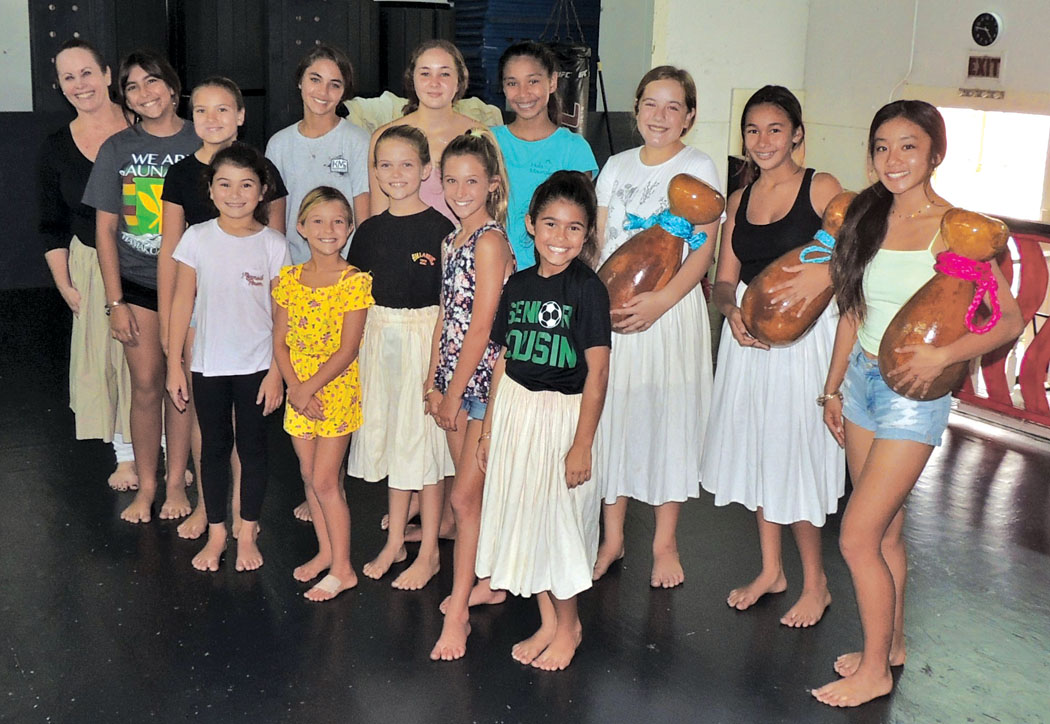
Sadly, in August 2019, Lelehua and Manu were involved in a motorcycle crash, and Manu’s injuries were extensive. Recovery was long and extensive, and they are both very grateful for the community’s generous kōkua.
Lelehua’s “day job” is with the travel company Expedia, for which she earned the title of Hawai‘i Concierge of the year in 2018. “I’ve been in customer service all my life,” she says. “I love people. I love sharing the island.”
“I think it is our kuleana to direct our visitors. I think social media and books can tend to misdirect our visitors,” she continues. “I’m going to tell you about your journey to Mauna Kea and Mauna Loa, what the words mean, why they are so important. I’m going to make sure that our visitors have a little more understanding of the place names they are going to see. They so want to embrace Hawaiian culture.”
It is also her belief that there are certain places that should not be exploited because of their sacredness. “The environmental impacts on these places have been devastating. This is something I am very passionate about!”
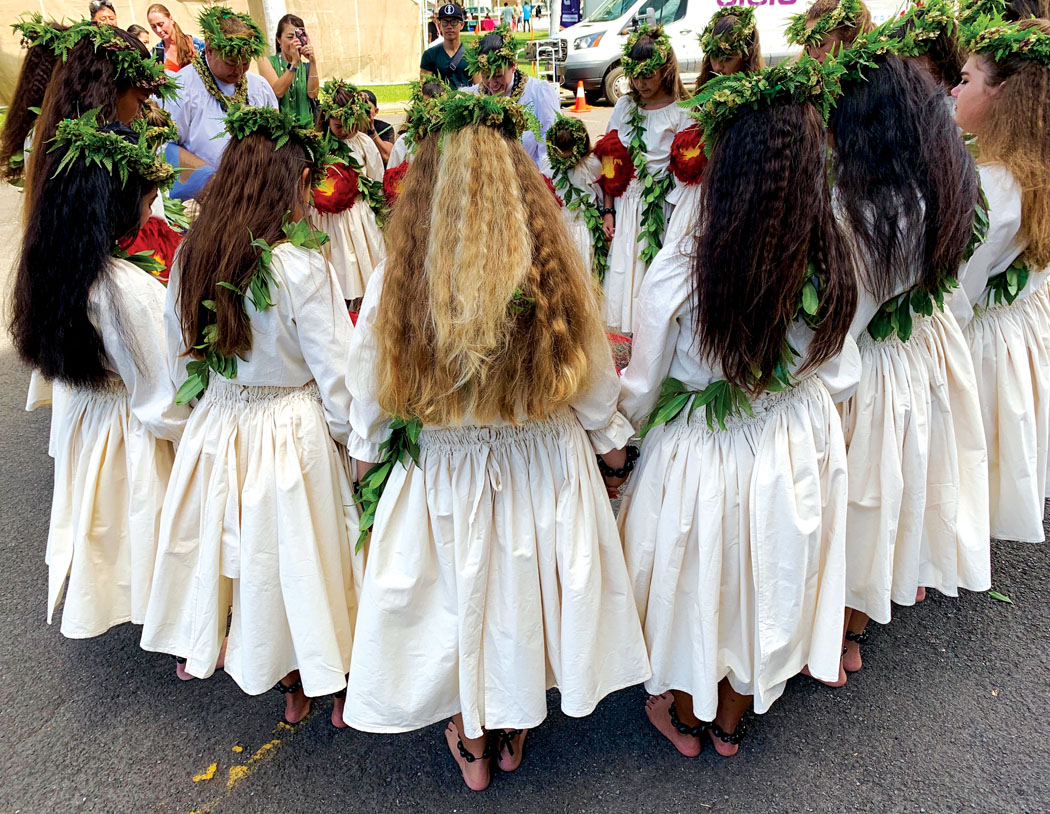
In her hula class at the old theatre, Lelehua speaks to her dancers. “It is a gift to be able to teach you.” “This song, ‘Pua Lililehua,’ was written for Aunty Maiki,” she says, speaking of her hula “ancestor,” legendary kumu hula Maiki Ai‘u Lake. “She died while teaching hula, and the legacy she left us is amazing. Not only did she teach my kumu, Michael Pili Pang, she taught and graduated some of the most noted kūmu hula of today. She graduated Uncle Robert Cazimero, Aunty Vicky Holt, and many others whom have continued her hula genealogy and carried on her legacy.”
Someone has asked if she understands every word of the mele they are rehearsing. “Only the writer can tell you what the song is really about,” she says. “I was taught by my kumu to understand what I am teaching, to embrace the kaona behind the mele, but also to be creative and document my experiences as they happen in this era.”
She flashes back to another part of her family’s story. “My great-grandfather spoke Hawaiian at home as his first language. On the way to Kamehameha School, he was told not to speak Hawaiian at school.” She shakes her head, thinking, then continues. “There’s nothing Hawaiian about that, about putting people down. It’s Hawaiian to be loving and kind. That is Hawaiian. My Papa used to say, ‘My mo‘opuna, be humble, kind and gentle to all forms of life!ʻ” ❖
All photos, unless otherwise specified, are courtesy of the Bray ‘ohana.
For more information: MartialArtAchievementCenter.com
Mahalo Kings’ Shops—Culture Story Sponsor
